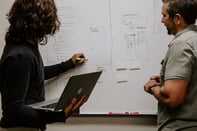Published on
Finding a Seat at the Table: Continuing Education in the Modern Postsecondary Organization (Part 1)

Continuing Education (CE) divisions have long been seen as an addendum to the core higher education institution—a cash cow with little connection to the main campus. As the recipe for success in the postsecondary space evolves, however, so too has the role of CE. After all, today’s institutions need to be responsive to student and labor market demands. They need to compete to attract learners and work hard to retain them. These were never considered to be important to the traditional institution, but have always been the bread-and-butter of a strong CE organization. In this interview, the first of two parts, James Broomall reflects on the role CE divisions are playing in today’s higher education institutions and shares some insights into what CE leaders need to do to maintain their seat at the table.
The EvoLLLution (Evo): What are some of the core challenges facing mainstream higher education today?
James Broomall (JB): I think many of the core challenges facing mainstream higher education cluster around this question of what a college education means today, and how can we deal with the escalating costs facing colleges and universities.
This leads to two key questions around higher education’s value proposition. First, is college worth the cost? And second, if it’s worth the cost, how do you measure that value? Do you measure value in financial terms or in terms of personal development? Return on investment is really hard to measure, because you can measure return financially but the other aspects that come with a college education have a lot of value but it’s hard to communicate that to the many stakeholders we have.
The second challenge follows the first challenge. We continue to wrestle with this issue about whether higher education is a public good or a private good. Is it something that benefits the individual or society in general? Or, as a third option, does the true value lie somewhere between the two? Over the last 30 to 40 years, those of us who work in public universities have always said that higher education is primarily a public good—as we serve the greater public—and then we’re secondly a private good in that we serve individuals. Today, though, that’s becoming confused. Even on our own campuses there’s a debate as to whether higher education is a public good or a private good. This, of course, has significant ramifications for how we organize, what we charge, what kinds of programs we develop—it lies at the core of everything we do.
The third challenge is identifying the stakeholders to whom we’re accountable, and the number seems to increase every day. Under the Obama Administration, there has been more intervention at the federal level around issues like employability. The states are becoming increasing involved in things like distance learning and creating additional accountability measures that lie on top of existing accountability measures in place from our alumni and our boards of trustees. If you’re a public university, your funding sources—your higher education board, your state legislature, all these multiple stakeholders—have different views of what college is worth and how it should be defined.
These central challenges are all pushing in on mainstream higher education at a time when resources are already diminishing.
Evo: How can CE leaders help solve these issues?
JB: As a starting point, continuing education leaders need to be more effective at communicating the broad nature of our mission. We’ve been almost a victim of our own success as we’ve become larger and more prosperous.There’s a tendency to identify our value primarily from cash contribution—the old model of continuing education as an alternative revenue stream or cash cow.
To be able to show the additional value we bring to the institution, we should more actively try to align our mission in continuing education with the mission and vision of our broader institution. By aligning the continuing education organization with the rest of campus, you can show how you do more than just stay agile— you can show your organization’s ability to evolve incrementally while creating additional value. It all starts with aligning with the broader institutional mission and vision.
There are a number of other traits that we have here that are probably helpful in this day and age. For example, we’ve always had to be boundary spanners, working to form bonds and partnerships across the institution and beyond. We have to work with faculty, with both individual and corporate clients, with accrediting bodies and with professional associations. Being able to step outside one’s faculty is critical across the institution today and we can demonstrate how you expand the boundaries between the campus and various stakeholder constituencies.
We’ve shown as a field that we are fairly resilient. Continuing education organizations go through expansions and contractions, but there’s a resiliency and an ability to reinvent ourselves, which is the really important for higher education as institutions try to remain relevant and responsive to shifting market demand.
Additionally, CE’s culture of innovation and entrepreneurship would be of great value to the rest of the institution. CE organizations are always looking for another way to solve the problem because we’ve always faced resource challenges. Now that the rest of campus is starting to experience this, it’s critical to understand how to approach issues from different angles.
The last one benefit CE can bring to the table, one that I’m beginning to realize now is more important than ever and plays off our innovative culture, is our contingency management. What happens when things go wrong? What happens when the strategic plan goes off track? Continuing educators tend not to be as linear in our thinking and approaches—we tend to be more broad-based and creative. Those are traits that seem to be more valued now on the central campus than maybe they once were historically.
Evo: What are some of the most significant roadblocks standing in the way of CE’s wider participation in these discussions?
JB: Higher education as a field is hierarchical. There is a hierarchy that organizes disciplines, campus functions—everything across the institution exists as part of this hierarchy. Since continuing education’s mission has always been to deal with the alternative to the normal—the non-traditional student, the non-traditional program—there’s a sense that we’re peripheral to the main mission. As a result, we have this value, but that value isn’t perceived to be integral to the function of the main campus university. Some time ago, a colleague introduced me like this: “This is Jim, he runs his own little university up on north campus.” That’s common, the sense that continuing education runs its own university and while it’s really not the main business of the institution, it’s tolerable as long as it generates revenue. That historical status ambiguity can create significant roadblocks to CE’s capacity to contribute to main campus development.
The second roadblock is that we haven’t, as a field, done a very good job of building a research agenda for adult and continuing education. The rest of campus wants to understand the research foundation of our field. In other words, what are the theories and knowledge that guide adult and continuing education? In the academy, especially in a research university, you really have to have that respect. You need to demonstrate that you’re working from a position of research, whether it be quantitative or qualitative. We’ve tended to act more on the basis of best practice—what works and what doesn’t—and as a result we haven’t developed much “street cred” among the faculty.
The third roadblock is the socialization challenges CE leaders can have. Typically, continuing education has not been a pathway to senior leadership positions, particularly at research universities. People who are in the senior decision-making roles don’t really come from our background, so they tend to have preconceived notions about what we do, which can unfortunately lead to some marginalization. Having said that, we can also be our own worst enemies in this regard. Over years, we’ve built these operations that are fairly autonomous and have been happy to be left alone by senior leadership, rather than trying to show how we add value to the broader institution.
It’s really no different than the old statement by David Reisman, “Higher education is a snake with Harvard at the head.” Everybody follows that Harvard model, and as a result the ideal postsecondary model is residential, highly selective and research-oriented. So, even though less than a third of today’s students fit that traditional 18- to 24-year-old profile, if you’re a research school this type of student is still seen as the gold standard. Getting past this mindset requires personality and creative leadership from continuing education leaders. It’s critical to build alliances and to align the CE organization with the rest of campus. CE leaders need to understand and adapt to the institution’s overall vision, mission, strategy and priorities. This allows CE to understand how they can add value, and by extension, how to gain influence.
This interview has been edited for length. Click here to see the second instalment.
Author Perspective: Administrator



